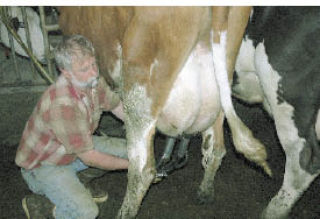Feed prices up, profits down, so more are letting cows go
The changing face of the Enumclaw Plateau is played out on several fronts.
Commuter traffic has increased, the Weyerhaeuser mill disappeared and, finally, the dairy industry continues its downward slide.
The plight of Plateau dairies was evident on a recent Thursday morning at the Stolz and Daughters Dairy on 400th Street Southeast, where John and Cindy Stolz were spending one final day milking their herd.
A wicked combination of higher feed prices and lower pay for their milk prompted the couple to seek a buyout from a national cooperative of milk producers. Their cows were to be sold and, in the blink of an eye, the dairy would be out of business.
“It’s been a good run,” said John Stolz, who started in the dairy business at 15, working with his father. He’s now 52.
Stolz recalls where there were perhaps 40 dairies dotting the Plateau, occupying fertile land around Enumclaw and Buckley. Now, he said, there might be 17 or 18.
In one sense, it is the dairyman’s efficiency that has created part of the problem, Cindy Stolz said. Advances on the farm have improved mortality rates and technology has allowed breeders to come up with a lot more heifers. That means more milk in the marketplace and, in the world of supply and demand, overproduction pushes prices downward.
The bottom line is, making a living by milking cows is a dicey proposal, compared to the old days.
Still, the decision to accept a buyout and walk away from the daily ritual of milking cows didn’t come easy.
“We talked about it for about a year,” Cindy Stolz said. Her husband finally double-checked all the math and submitted a number to the national organization that runs the buyout program. It was accepted and the family had two weeks to close up shop.
“This isn’t a get-rich-quick scheme,” Cindy Stolz explained. “We’ll still have to work.”
She has earned her license to be a nurse’s assistant and John Stolz will remain on the family farm, raising “young stock” that will head to a family friend’s dairy in Eastern Washington.
That friend is Eddie Zurcher, a former Plateau dairyman who headed across the mountains.
The new life will bring new hours, as few occupations present the day-in, day-out demands of a working dairy. Cows really don’t care if it’s a weekend or a holiday; they need to be milked twice a day.
For John and Cindy Stolz, their workday started at 3:30 a.m. with the wakening call of the alarm clock. By 4, Cindy was on horseback, heading into one of four pastures to herd cows to the milking barn. The barn accommodates 16 animals that could be milked in about 45 minutes; it took eight shifts to get through the entire herd.
John’s workday usually ended by 5 p.m., unless it was haying season. Then, work would continue until perhaps 9 or so, when an 18-hour day would mercifully come to a close.
Counting down the days until his final milking, John Stolz was realistic about the current state of his industry.
“I thought I’d get another 10 years of doing this,” he said, bending over to attach a milking machine to another udder. “But things haven’t worked out, so it’s time to go.”
Stolz isn’t the only dairyman making the tough call to leave his job and lifestyle behind. He said 366 dairies nationwide will cease production this year, meaning 102,000 fewer cows being milked. Stolz isn’t the only dairyman on the Plateau taking the buyout this year, and others in the area have made the same call in recent years.
While explaining what their new life will hold, Cindy Stolz can’t help but wonder about the impact the disappearing dairy scene will have on her adopted hometown. Fewer dairies mean fewer jobs for those to haul milk, sell supplies and help tend to the farms.
“There’s a ripple effect,” she said. “And it’s kind of scary.”
Reach KevinHanson at khanson@courierherald.com or 360-802-8205.



